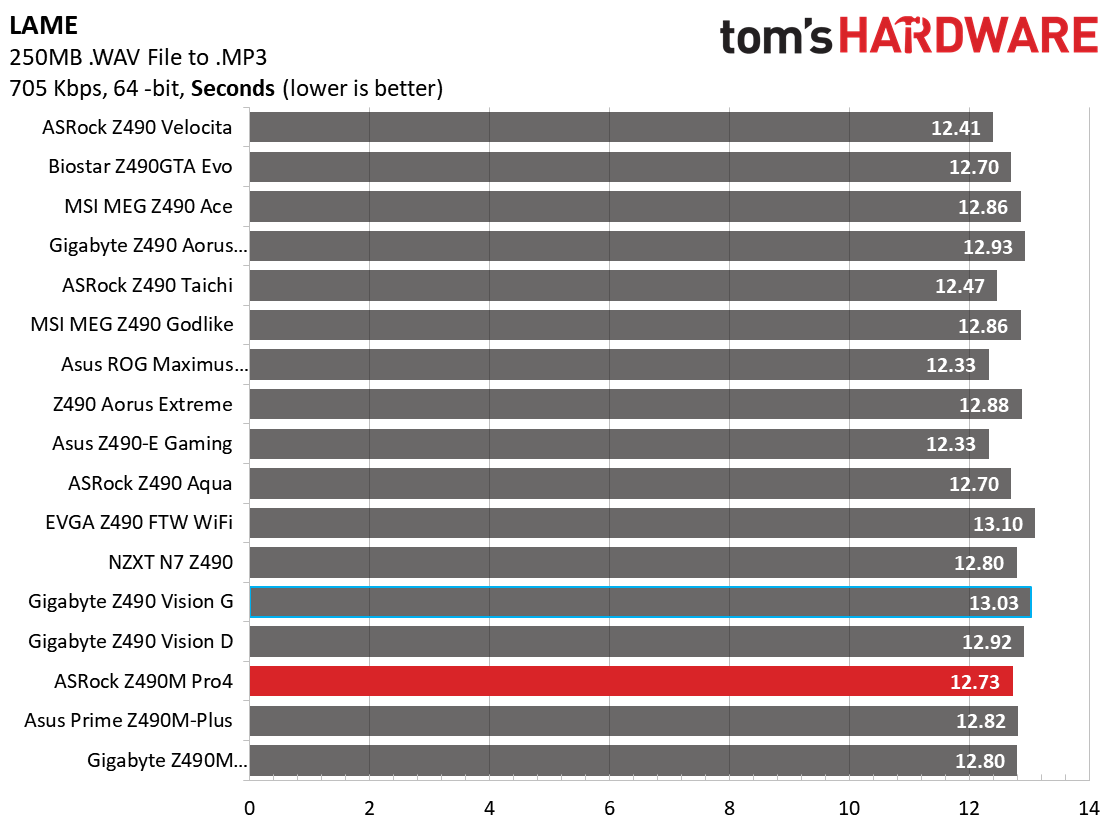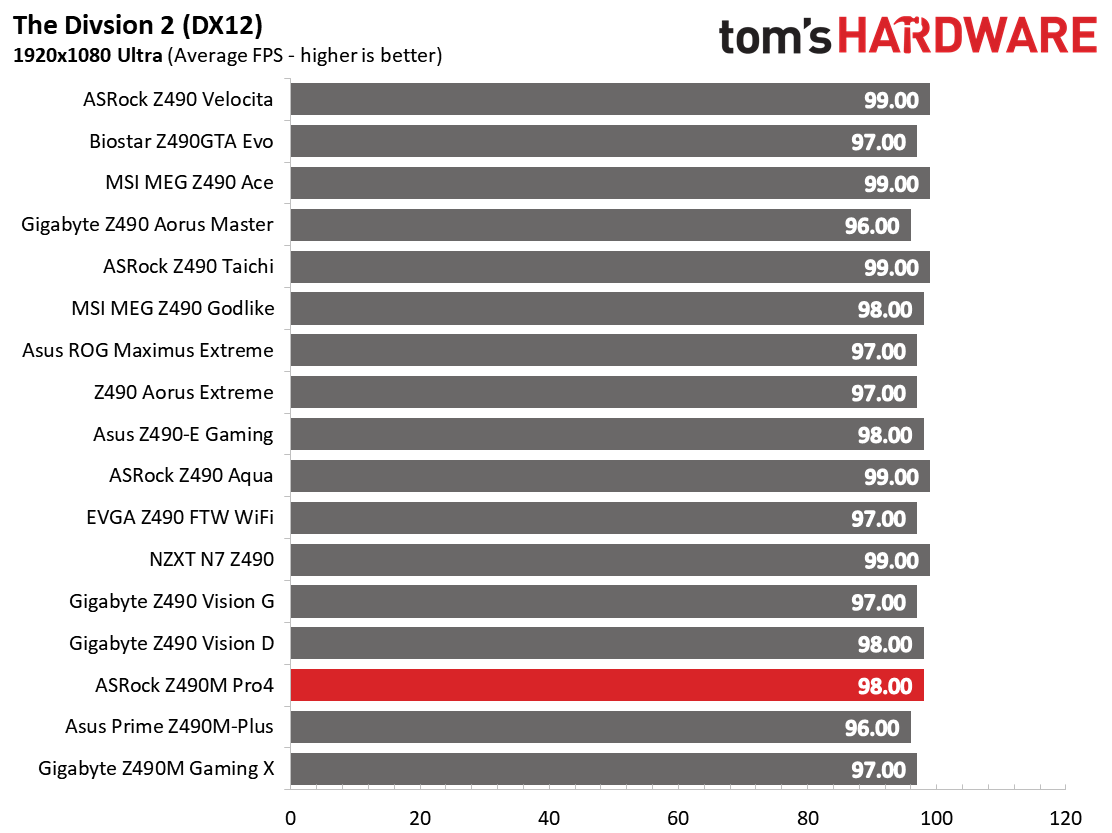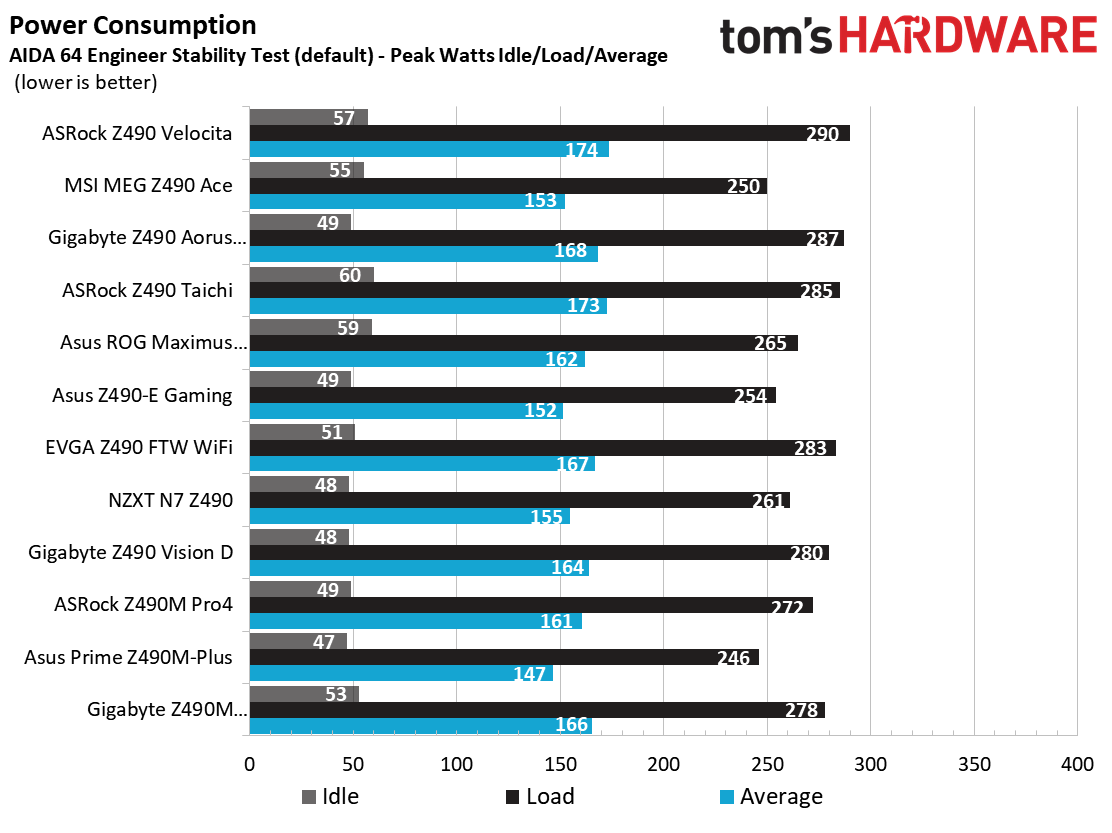Budget Micro ATX Z490 Roundup: Inexpensive ASRock, Asus and Gigabyte Boards Battle
Small size and price, but plenty capable
Test System
Our test system uses Windows 10 64-bit OS (1909) with all threat mitigations applied. The motherboard BIOS used is the latest non-beta available to the public, unless otherwise noted. The hardware used is as follows:
| CPU | Core i9-10900K | Row 0 - Cell 2 |
| Memory | G.Skill Trident Z Neo 2x8GB DDR4 3600 (F4-3600C16Q-32GTZN) | Row 1 - Cell 2 |
| GPU | Asus ROG Strix RTX 2070 | Row 2 - Cell 2 |
| CPU Cooler | Corsair H150i | Row 3 - Cell 2 |
| PSU | Corsair AX1200i | Row 4 - Cell 2 |
| Software | Windows 10 64-bit 1909 | Row 5 - Cell 2 |
| Graphics Driver | Nvidia Driver 445.75 | Row 6 - Cell 2 |
| Sound | Integrated HD audio | Row 7 - Cell 2 |
| Network | Integrated Networking (GbE or 2.5 GbE) | Row 8 - Cell 2 |
| Graphics Driver | GeForce 445.74 | Row 9 - Cell 2 |
Benchmark Settings
| Synthetic Benchmarks and Settings | Row 0 - Cell 1 |
| PCMark 10 | Version 2.1.2177 64 |
| Row 2 - Cell 0 | Essentials, Productivity, Digital Content Creation, MS Office |
| 3DMark | Version 2.11.6866 64 |
| Row 4 - Cell 0 | Firestrike Extreme and Time Spy Default Presets |
| Cinebench R20 | Version RBBENCHMARK271150 |
| Row 6 - Cell 0 | Open GL Benchmark - Single and Multi-threaded |
| Application Tests and Settings | Row 7 - Cell 1 |
| LAME MP3 | Version SSE2_2019 |
| Row 9 - Cell 0 | Mixed 271MB WAV to mp3: Command: -b 160 --nores (160Kb/s) |
| HandBrake CLI | Version: 1.2.2 |
| Row 11 - Cell 0 | Sintel Open Movie Project: 4.19GB 4K mkv to x264 (light AVX) and x265 (heavy AVX) |
| Corona 1.4 | Version 1.4 |
| Row 13 - Cell 0 | Custom benchmark |
| 7-Zip | Version 19.00 |
| Row 15 - Cell 0 | Integrated benchmark |
| Game Tests and Settings | Row 16 - Cell 1 |
| The Division 2 | Ultra Preset - 1920 x 1080 |
| Forza Horizon 4 | Ultra Preset - 1920 x 1080 |
Benchmark Results
All standard benchmarks and power tests are performed using the CPU’s stock frequencies (including stock Thermal Velocity Boost), with all power-saving features enabled. Optimized defaults are set in the BIOS and the memory is set using the XMP profiles. For this baseline testing, Windows is set to High Performance, except for during power testing, where we switch to Balanced so the PC idles properly.
Note that the red bar represents the best result between the three boards we’re testing here, not the fastest/slowest result for a given chart.
Synthetic Benchmarks
Synthetics are a great tool to figure out if a board is running out of spec, as identical settings should produce extremely similar performance results. Advanced memory timings are the one place where motherboard makers can still optimize for either stability or performance though, and those settings can impact some testing.




















Results in our synthetic benchmarks matched other boards in both single- and multi-threaded applications. These boards traded punches in our synthetic benchmarks. About the only outliers in performance are the Asus and Gigabyte, both of which scored lower than any other board so far in PCMark 10’s Video Editing and Video conferencing.
Timed Applications



During the timed applications, most results were in line with the other boards tested. We saw anomalies with the ASRock and Asus boards in Handbrake and Corona, where these took longer than most other boards due to the sustained clock speeds being lower over time.
3D Games and 3DMark




We’ve updated our game tests to more The Division 2 and Forza Horizon 4. The games are run at 1920x1080 resolution using the Ultra preset. As the resolution goes up, the CPU tends to have less of an impact on most games. The goal with these settings is to determine if there are differences in performance at the most commonly used resolution, with settings most people use or at least strive for.
Get Tom's Hardware's best news and in-depth reviews, straight to your inbox.
On the gaming front, all tested boards performed as expected. There’s nothing of concern here, and no disadvantage over much-pricier alternatives.
Power Consumption / VRM Temperatures

For power testing with our current-hungry Core i9 CPU, we used AIDA64’s System Stability Test with Stress CPU, FPU and Cache enabled using peak power consumption value within the first minute. The wattage reading is taken from the wall via a Kill-A-Watt meter to capture the entire ecosystem (minus the monitor). The only variable that changes in these reviews is the motherboard; all other parts are the same.
Power use in our roundup wasn’t much different than the other full-size motherboards we’ve tested in the past. On average, the Asus Prime used the least amount of power, idling at 47W with load voltage peaking at 246W. These values are the lowest we’ve seen so far. The other two boards were in the same ballpark though, with the ASRock running 49W/272W and the Gigabyte running 53W/278W (idle/load).







On the overclocking front, both the Gigabyte Gaming X and Asus Prime handled things without issue. The Gigabyte peaked well over 100 degrees Celsius, though it was still within operating parameters. The Asus board peaked just above 70 degrees Celsius. Clearly, temperature-wise, the Asus implementation runs the coolest all-around, even beating boards with active cooling (fans) on the VRM.
VRM temperatures, on the other hand, were all over the place. Of the three boards, the Asus Prime ran the coolest, barely reaching 50 degrees Celsius. Compare that to the Gigabyte Gaming X, which almost reached 100 degrees Celsius and the ASRock, that hit around 84 degrees Celsius. We saw a wide swath of temperatures. That said, at stock speeds, we didn’t have any issues. While a couple of these boards ran hot, they were within operating parameters.
Overclocking
Cutting to the chase, only the Asus and Gigabyte boards were able to overclock here. The ASRock ran into current limits even at 5 GHz, so we didn’t bother testing. That said, the other boards ran our Core i9-10900K CPU at 5.2 GHz and about 1.35V while keeping the CPU around 90 degrees Celsius. With both boards, some LLC was needed to keep the voltage stable, but that is par for the course in overclocking (vdroop is actually a part of the intel specification).


All motherboards tested were able to set our 2x8GB DDR4 4000 kit without issue. The Gigabyte and Asus list the fastest supported speeds, though remember your mileage will vary reaching them, achievable speeds are memory kit and CPU dependent. That said, if you’re in the market for a budget motherboard such as these, chances are you aren’t looking for the top-of-the line memory speeds. Any of these boards will work fine on the memory front, at least up to DDR4 4000 with the kit we use.
Final Thoughts
All three of these boards performed well at stock, with the results mostly in line with each other. Features wise, all include what you need, though some may feel the six USB ports on the rear IO is a bit anemic. All of these boards contain at least four SATA ports and one M.2 slot, though none include Wi-Fi. At these price points, ASRock Z490M Pro 4 ($134.99), Asus Prime Z490M-Plus ($149.99), and a Gigabyte Z490M Gaming X ($159.99), that’s to be expected.
The Gigabyte Z490M Gaming X’s biggest selling point is its appearance, along with the full set of six SATA ports. Where it falls short compared to the others is the single M.2 socket. The ASRock Pro4, on the other hand, brings two M.2 sockets and four SATA ports. If you still use a lot of SATA based drives, four may not be enough (only three when using M2_1). The Asus splits the difference here, sporting five SATA ports and two M.2 sockets (four total when M2_2 is used in SATA mode).
On the audio front, none of these are going to please an audiophile. However for simple listening, the onboard solutions will be fine. To that end, Gigabyte and Asus both use a more premium Realtek solution than the ASRock board. On the networking front, all boards use Intel I219-V Gigabit adapter and do not come with Wi-Fi. Only the ASRock includes a Key-E M.2 socket for Intel CNVi Wi-Fi capability.
In the end, all of these boards prove to be a capable base on which to build your Z490 based system. If overclocking is part of the plan, stick with the Asus or Gigabyte. If you need an easy Wi-Fi implementation and don’t plan on overclocking, the ASRock board is the weapon of choice and the cheapest of all we’ve tested. That or you can pay a premium ($189.99 or $20 more than the Gigabyte) for the MSI MPG Z490M Gaming Edge Wi-Fi that includes Wi-Fi, solid VRM, and four SATA ports. While all have their limitations, it’s not a hard choice to pick the best of the three boards we reviewed here. That goes to the Asus Prime Z490M-Plus, as it offers a good value, a mix of appreciated features, and it’s priced right, while running cooler than some boards that cost much more.
MORE: Best Motherboards
MORE: How To Choose A Motherboard
MORE: All Motherboard Content

Joe Shields is a staff writer at Tom’s Hardware. He reviews motherboards and PC components.